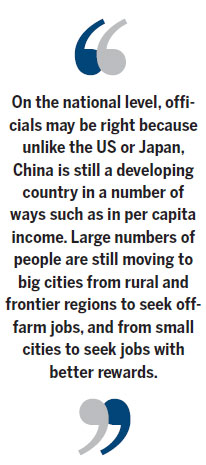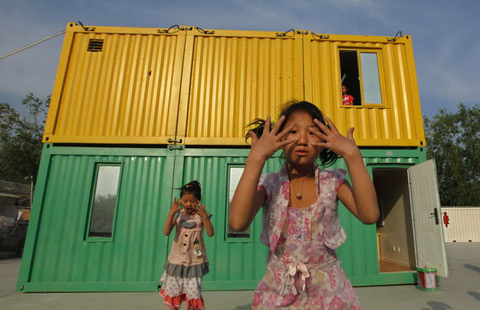Cities with potential can resist bubbles
Updated: 2014-03-28 08:41
By Ed Zhang (China Daily Europe)
|
|||||||||||
Growing urbanization means places that continue to attract workers will be attractive to investors
How do people compare China's housing market with the bubble in Japan in the 1980s, or that in the US in the 2000s? It is an important question because it determines the answer to an even larger question: what is a safe bet for investors in China?
The business media has run features about China's "ghost towns" built with huge investment and row after row of empty houses showing little trace of human activity.
In the last couple of weeks, more alarms were sounded - such as local real estate companies going under after failure to pay back their debt, and development funds defaulting when their bonds matured. The government has not stepped in to bail out the companies, and is unlikely to do so.

Even an economically-strong central government would balk at intervening, given the potential scale of the problem. It can address the issue only in a select number of cities and industries.
Economists say at least 60 percent of all companies listed on the A-share market have invested in real estate development during the last decade of unprecedented rise in asset prices. And needless to say, all banks have housing mortgages as a main source of revenue.
Wouldn't it be a nightmare if real estate prices tumble in city after city, and even in Beijing and Shanghai, and if the real estate industry proves poisonous to banks' credit standing, and to the bond and stock markets?
No, no, no, say officials. We'll manage to do just fine, they pledge. But investors need to know how.
On the national level, officials may be right because unlike the US or Japan, China is still a developing country in a number of ways such as in per capita income. Large numbers of people are still moving to big cities from rural and frontier regions to seek off-farm jobs, and from small cities to seek jobs with better rewards.
In response, the central government has come up with a plan to, from 2014 through 2020, help 100 million workers from rural areas who already work in cities to enjoy all social benefits, help a second 100 million poor urban residents improve their housing, and help a third 100 million move into the cities in central and western China.

Overall, China's urbanization ratio (people living in cities versus the entire population) is just above 50 percent. The figure is still lower if only those certified as urban residents are counted. A general tumbling of real estate prices is only possible when a nation's urbanization ratio exceeds 60 percent, said an official from the Ministry of Housing and Urban-Rural Development, citing examples that the same index is about 70 percent in the US, 67 percent in Japan, and 65 percent in Europe.
However, all this applies only at the macroeconomic level. There could still be a world of difference between one city and another. While the country may still be some distance from a housing market collapse, dangerous over-supply (evidenced by all the ghost towns) will cripple the economies of second, third, and fourth-tier cities that fail to attract new workers.
This is already happening. It is bringing down smaller real estate developers and is a threat to banks with high exposure to housing and other development projects in smaller cities. In aggregate terms, the mini-crisis will wipe out the worth of newly-built assets in many cities.
In the meantime, polarization will become more evident between cities having continuing growth and the rest; or between places rich in opportunities and those with waning appeal. The process can only continue to grow in the country's urbanization drive.
China has enough large cities or city clusters of 10 million or more people, and for them, to collectively absorb 100 million migrants wouldn't be as staggering a task as it appears.
So, for investors, the crucial thing to do is perhaps not to try to predict the rise or fall of China's general business cycle, but to be clear about which part of China they put their money in.
The author is editor-at-large of China Daily. Contact the writer at edzhang@chinadaily.com.cn
(China Daily European Weekly 03/28/2014 page15)
Today's Top News
Partnership with Belgium, EU highlighted
Turkish PM wins local elections
Monday's search for MH 370 resumes: AMSA
Families of flight MH370 passengers 'need closure'
Greece passes new reform bill
Dobass demonstrators demand referendum
MH370 relatives demand answers
Turkey starts local elections
Hot Topics
Lunar probe , China growth forecasts, Emission rules get tougher, China seen through 'colored lens', International board,
Editor's Picks

|

|

|

|

|

|





